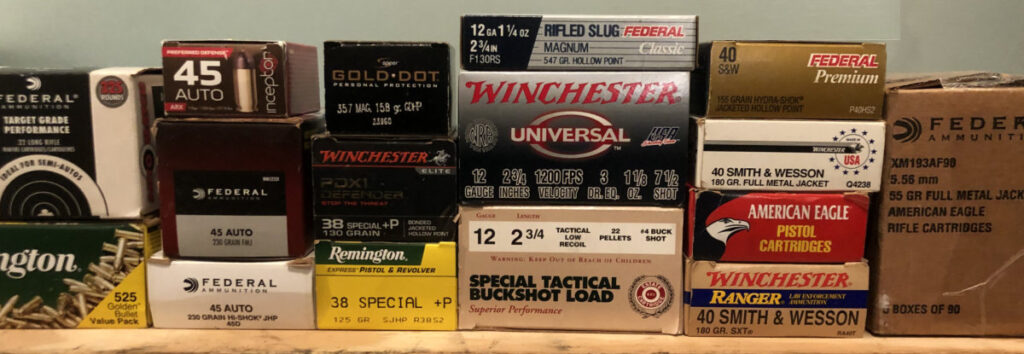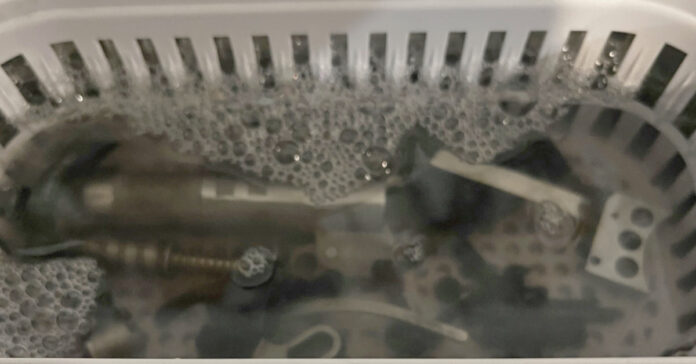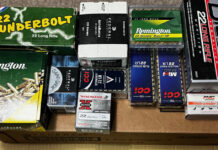I finally disassembled and cleaned the firearm that had been stolen from me back in 2019, which I just recovered a couple weeks ago. It was far from its previous like-new condition, but was still fully functional. After five years without being cleaned, dirt and grime were caked in places like under the grips and in crevices and corner of the frame. Instead of field stripping it, I broke it down into its individual components and sent it through the ultrasonic cleaner. Some pieces were run through twice.
Once it was clean, I noticed the signs of wear and a few scratches in the bluing that hadn’t been there when I last saw it. Darn! I guess that criminal wasn’t as careful with his guns as I had thought. Still, after I reassembled and lubed it, the gun shot just fine.
The last time I worked on a 1911, I had to replace the extractor, and disassembling the slide is pretty easy. I think the last time I completely disassembled a 1911 was back in the ‘90s when I shot USPSA, so it had been a while. Thankfully, it’s largely intuitive. The disconnector, rocker, and firing pin safety of this model were different from the other 1911s I own. It came apart just fine but took me two tries to reassemble that portion of it just right. It was a reminder of why I rarely go beyond field stripping.
Upgrades
After some online searching, I bought two new officer-size magazines. While I have standard 1911 magazines that will fit in the mag well just fine, they stick out the bottom of the grip. I now have three t magazines that fit flush for a total of 21 or 21+1 rounds. That should be sufficient, but I’ll probably stick with my Glock 48 and 24 rounds for daily carry.
Because I was online already, and they were only $18, I bought a pair of G10 grips to spice the gun up a bit. They are a step up from the basic rubber grips that came with it.
It’s no secret that I carry and like the Glock firearm. I own several in different calibers and sizes. But I also own more than one 1911, and while it holds half as many rounds as most Glocks, the 1911 has a great deal going for it. For long-term survival purposes, I can’t help but think that steel and aluminum 1911 with no plastic parts is going to hold up better over decades than a gun with many plastic parts. Just compare the robust slide release lever form a 1911 with the thin piece of metal in the Glock and you’ll understand what I mean.
Searching for Ammo
I have sufficient stores of .45 ammo on hand, including both Federal Hi-Shok and 230 grain ball, so I didn’t buy any new. I did, however, spot a deal on some 9mm ammo.
The better part of a decade ago, I settled on Hornady Critical Defense ammo in 115 grains as my preferred 9mm carry load, and I have seen no reason to change. I like the ammo design, which allows it to penetrate barriers and still expand in a soft-tissue target. The bullet design also makes it unlikely to over-penetrate, dumping most of its energy into the intended target, another plus.
The problem with this ammo, like any high-tech defensive ammo, is the cost. It usually sells for $1 to $1.25 per round. After some judicious searching online, I found the cheapest price and bought 150 rounds for about $143. Better than the $180 some places wanted to charge me.
Several times a year, I shoot my carry ammo. For example, when I buy new magazines, I test them with 115-grain ball ammo and if they work flawlessly, I run a couple of magazines of the carry stuff through them. It is an expensive test, but it’s cheaper than having a failure-to-feed in the middle of a gunfight with your life on the line.
I also bought ammo because I think this is a good time to stock up. Prices are reasonable and there’s good availability. Plus, we don’t know what the future holds.
The Economics of Ammunition
I can buy 100 rounds of FMJ 9mm for about $25. So when it comes time to buy ammo, I have to decide, do I buy 25 rounds of Critical Defense or another high-performance round, or am I better off buying 100 rounds of FMJ for the same price?
That’s a tough call, but I think the answer is to buy both. I will carry the high-performance ammo in my firearm now and after the SHTF, but I will practice with the less expensive ball ammo. If the time comes where I need to I trade or sell ammo, it will be the FMJ stuff. While the 9mm 115 grain FMJ has nowhere near the one-shot stopping power of a 230-grain FMJ .45ACP, it’s better than a sharp stick. If we end up running low on the high-performance ammunition post SHTF, I’ll load magazines with every other round until eventually, all I have left is FMJ.
I should note that I am equipped to reload 9mm and I have 1,000 hollow point bullets from Montana Gold in my stash ready to be reloaded. From a performance standpoint, I expect these reloaded rounds would be a compromise between the Critical Defense and FMJs.
If we end up doing some defensive fighting after the SHTF, I would hope we are in a position to use rifles rather than pistols. Relying on a pistol implies you have been surprised or have had to transfer from your primary long gun to a secondary pistol. Neither are ideal situations. I’d also prefer to use the stand-off power of a rifle to keep a potential threat at bay. Pistols are close-up or last-stand defensive weapons. So, act accordingly and stock plenty of rifle and shotgun ammo as well as pistol rounds.
War and Ammo Availability
There are two things that affect ammunition availability: supply and demand.
When the country is at war, demand jumps and production is snapped up by the government. This includes production at the huge Lake City plant, but also specialty ammunition and components from other manufactures. When all the small rifle primers are being consumed by companies making ammunition for the military, there isn’t much left for domestic ammo production or for reloaders to use. Likewise, if all the 77 grain bullets are being loaded into military ammunition, there isn’t much available for civilian shooters to buy. These supply constrains drives up prices.
On the other end of the supply and demand balance is increased demand by consumers. We saw this in 2020 and 2021 when firearm sales surged. Let’s assume that everyone who buys a gun also buys 200 rounds of ammo. So when 3 million more guns than usual were sold in the spring of 2020, that meant 600 million more rounds of ammo were sold. If some people bought 500 or 1,000 rounds, the number could top 1 billion, or more than an 8 percent increase in ammo sales. That’s enough to cause a demand shock.
But why, you may ask, does an increase in the sale of 9mm result in a shortage of .32 ACP ammo? Because ammunition manufacturers have a limited number of lines, and the fewer changeovers they make from one caliber to another, the more ammo they can produce. So if you are a manufacturer and can produce 2 billion rounds of 9mm, the hottest selling round, or you can produce 1.8 billion in a mix of calibers, you might focus on 9mm and skip producing calibers such as .32 ACP, .380 and even .38 Special until the market for 9mm stabilizes.
Higher Prices and Back Orders
Political theater also drives gun and ammo sales. If the Democrats were to try to pass a bill banning the same of more than 100 rounds at a time, gun owners would buy up the available supply of ammo in a week or less. Online stores would sell out in just a couple of days. Americans fear missing out, so any threat to the supply results in a rush to buy more ammo before it is too late.

Even attempts by stores to limit sales are ineffective. I know a guy who found a Walmart that had .22 magnum rounds in stock back during the Obama years when rimfire ammo was scarce, so he bought the limit of three boxes, or 150 rounds. Then he sent his wife and 22-year-old daughter in to each buy three boxes. In normal conditions, he would have purchased 200 rounds. Because ammo scarcity was a scary thing, he stocked up. That perpetuates the shortage. My guess is some of those rounds are still on his shelf.
Just-in-Time Inventory
In 2020 and 2021, we got to see in real time how little excess capacity there is in the supply chain. Systems are optimized to make just enough to meet demand. When demand jumps, the supply chain struggles to keep up. Adding a shift means hiring and training people, so it’s not something that can be done overnight. Building a new production line can take years and then manufacturers may be stuck with excess capacity when the market settles down. They don’t want that.
To avoid being at the whims of the marketplace, stock up. If you have a few thousands rounds, you don’t have to panic buy when the price goes up. We’re talking about ammunition, but the theory applies to everything from food to toilet paper.
The good news is ammunition stores well. The bad news is when you look at the prices on the box ten years from now, you’ll wish you had purchased more. I’m speaking from experience.








